Professional IT Culture: Case Study Analysis and SFI6 Framework
VerifiedAdded on 2023/06/07
|13
|2523
|312
AI Summary
This report analyzes a case study on professional IT culture and the SFI6 framework for career development. It includes stakeholder analysis, ethical theories, and ACS code of conduct. The report also justifies the responsibility levels and required skills for career development.
Contribute Materials
Your contribution can guide someone’s learning journey. Share your
documents today.
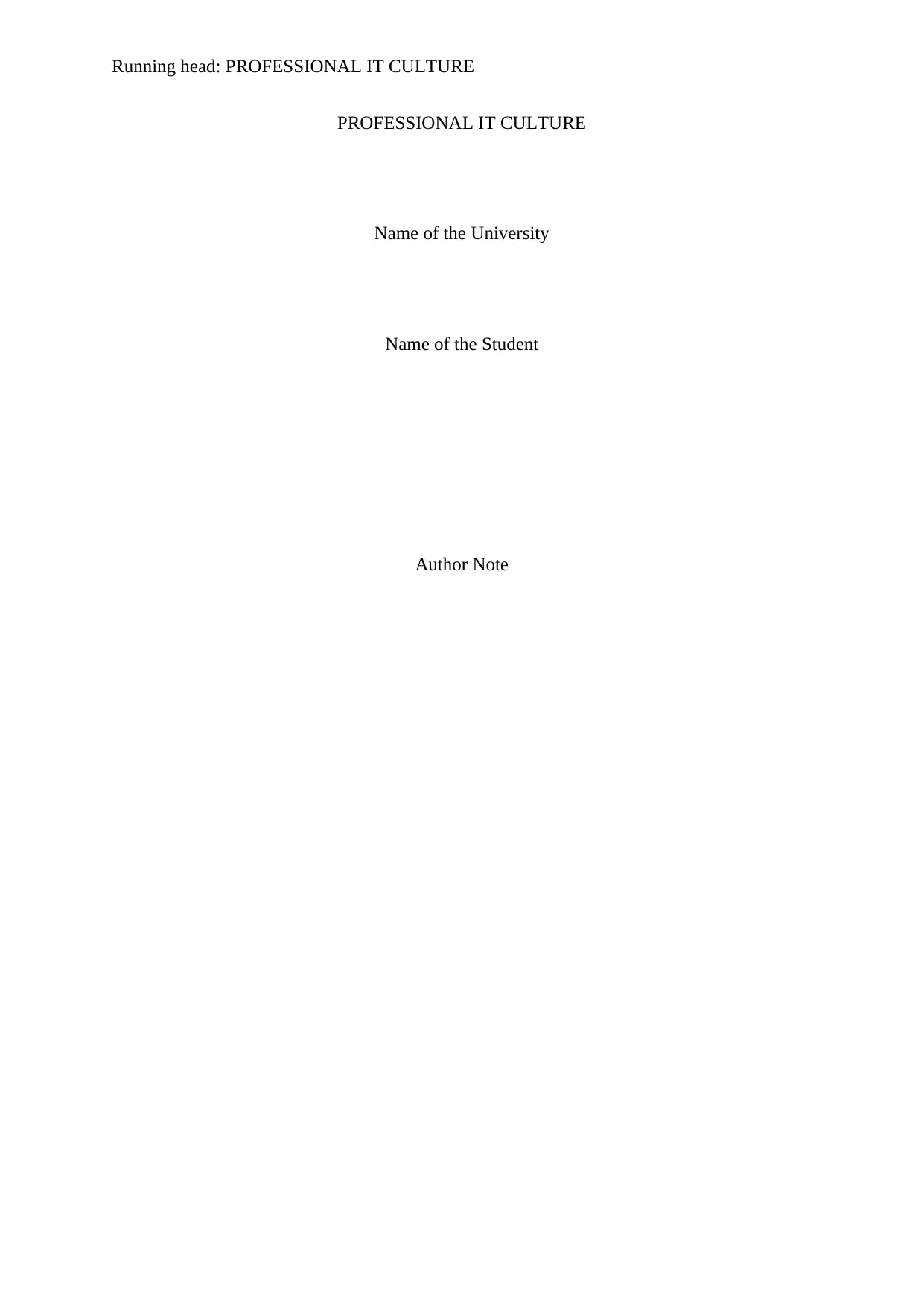
Running head: PROFESSIONAL IT CULTURE
PROFESSIONAL IT CULTURE
Name of the University
Name of the Student
Author Note
PROFESSIONAL IT CULTURE
Name of the University
Name of the Student
Author Note
Secure Best Marks with AI Grader
Need help grading? Try our AI Grader for instant feedback on your assignments.
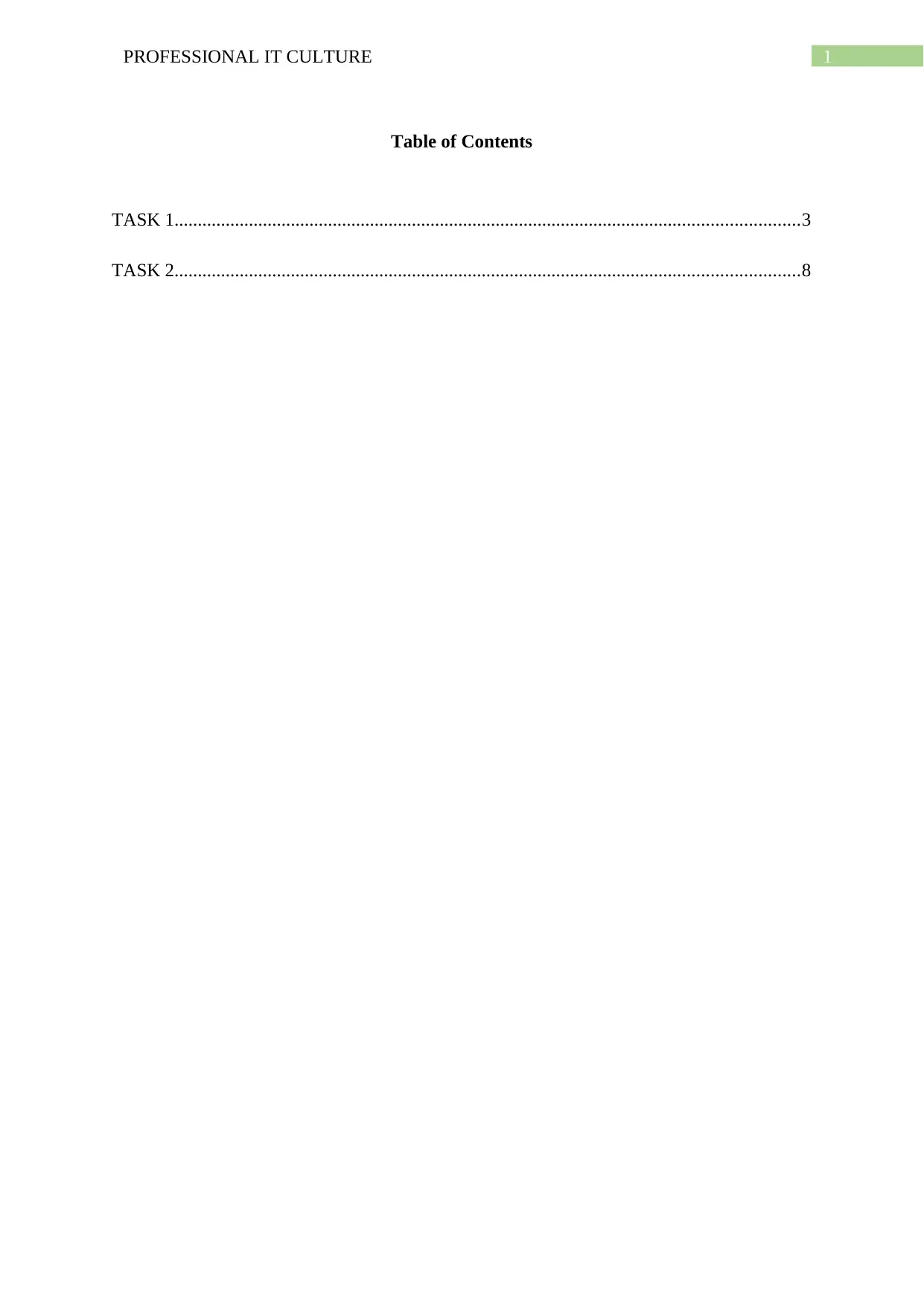
1PROFESSIONAL IT CULTURE
Table of Contents
TASK 1......................................................................................................................................3
TASK 2......................................................................................................................................8
Table of Contents
TASK 1......................................................................................................................................3
TASK 2......................................................................................................................................8
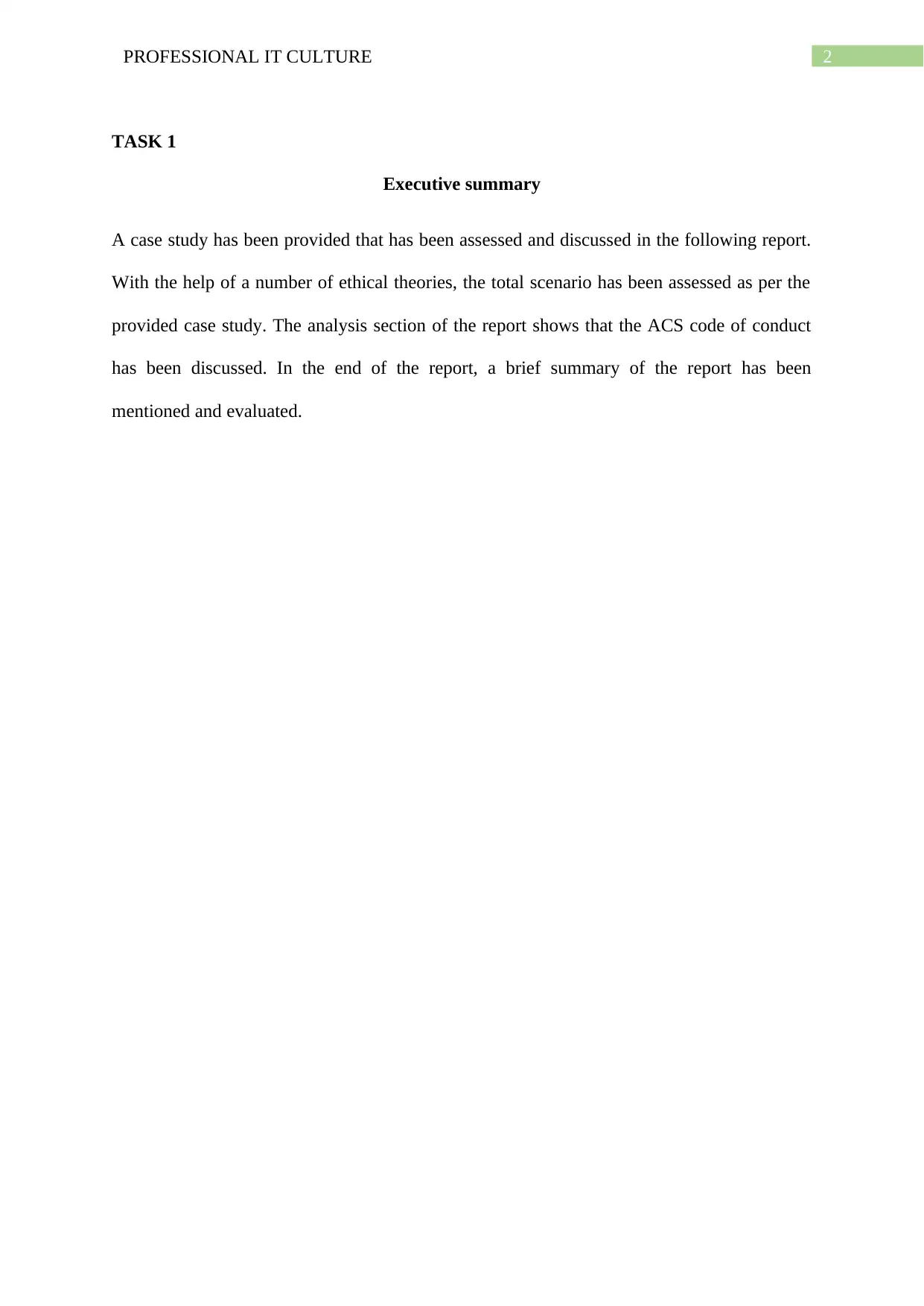
2PROFESSIONAL IT CULTURE
TASK 1
Executive summary
A case study has been provided that has been assessed and discussed in the following report.
With the help of a number of ethical theories, the total scenario has been assessed as per the
provided case study. The analysis section of the report shows that the ACS code of conduct
has been discussed. In the end of the report, a brief summary of the report has been
mentioned and evaluated.
TASK 1
Executive summary
A case study has been provided that has been assessed and discussed in the following report.
With the help of a number of ethical theories, the total scenario has been assessed as per the
provided case study. The analysis section of the report shows that the ACS code of conduct
has been discussed. In the end of the report, a brief summary of the report has been
mentioned and evaluated.
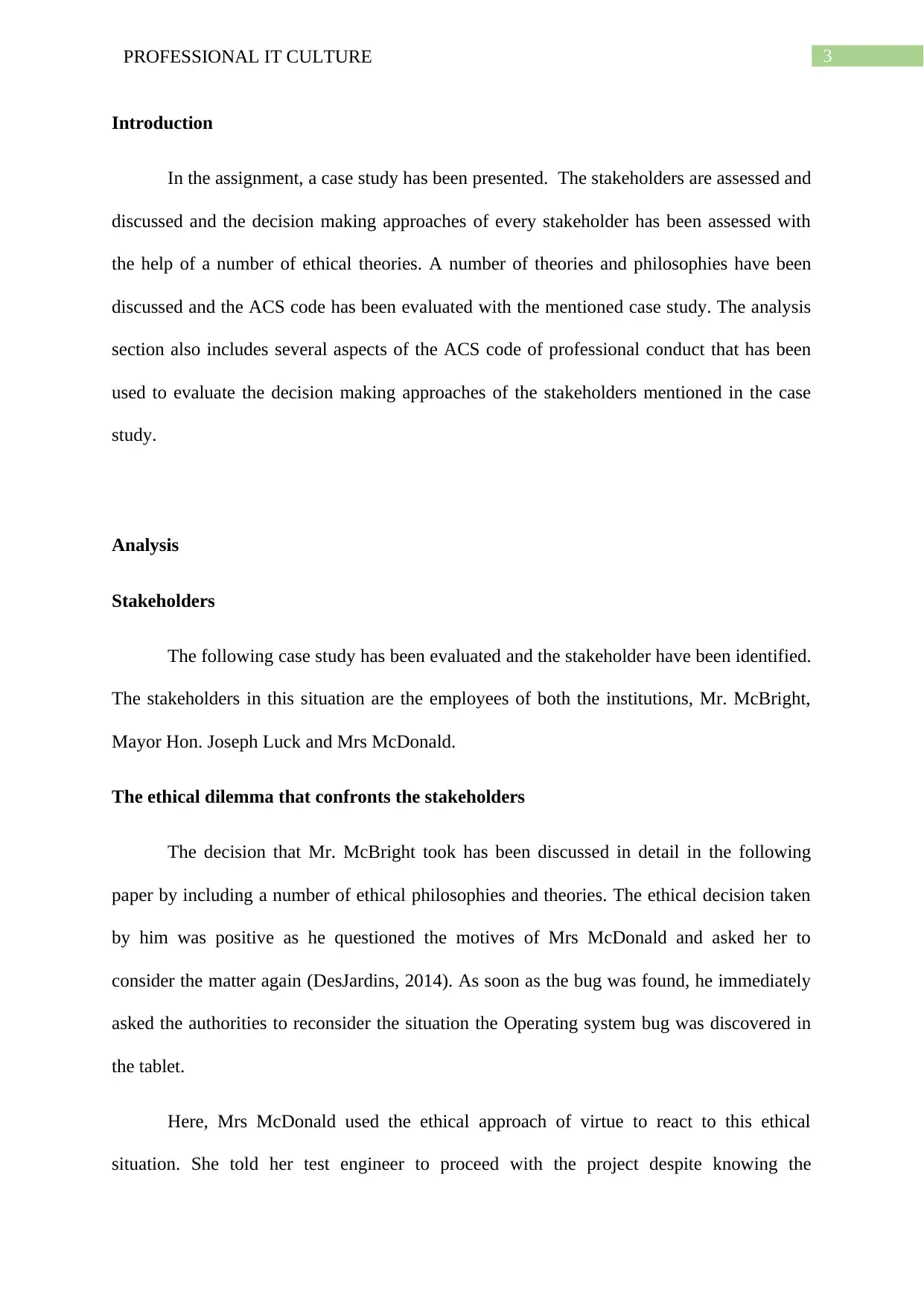
3PROFESSIONAL IT CULTURE
Introduction
In the assignment, a case study has been presented. The stakeholders are assessed and
discussed and the decision making approaches of every stakeholder has been assessed with
the help of a number of ethical theories. A number of theories and philosophies have been
discussed and the ACS code has been evaluated with the mentioned case study. The analysis
section also includes several aspects of the ACS code of professional conduct that has been
used to evaluate the decision making approaches of the stakeholders mentioned in the case
study.
Analysis
Stakeholders
The following case study has been evaluated and the stakeholder have been identified.
The stakeholders in this situation are the employees of both the institutions, Mr. McBright,
Mayor Hon. Joseph Luck and Mrs McDonald.
The ethical dilemma that confronts the stakeholders
The decision that Mr. McBright took has been discussed in detail in the following
paper by including a number of ethical philosophies and theories. The ethical decision taken
by him was positive as he questioned the motives of Mrs McDonald and asked her to
consider the matter again (DesJardins, 2014). As soon as the bug was found, he immediately
asked the authorities to reconsider the situation the Operating system bug was discovered in
the tablet.
Here, Mrs McDonald used the ethical approach of virtue to react to this ethical
situation. She told her test engineer to proceed with the project despite knowing the
Introduction
In the assignment, a case study has been presented. The stakeholders are assessed and
discussed and the decision making approaches of every stakeholder has been assessed with
the help of a number of ethical theories. A number of theories and philosophies have been
discussed and the ACS code has been evaluated with the mentioned case study. The analysis
section also includes several aspects of the ACS code of professional conduct that has been
used to evaluate the decision making approaches of the stakeholders mentioned in the case
study.
Analysis
Stakeholders
The following case study has been evaluated and the stakeholder have been identified.
The stakeholders in this situation are the employees of both the institutions, Mr. McBright,
Mayor Hon. Joseph Luck and Mrs McDonald.
The ethical dilemma that confronts the stakeholders
The decision that Mr. McBright took has been discussed in detail in the following
paper by including a number of ethical philosophies and theories. The ethical decision taken
by him was positive as he questioned the motives of Mrs McDonald and asked her to
consider the matter again (DesJardins, 2014). As soon as the bug was found, he immediately
asked the authorities to reconsider the situation the Operating system bug was discovered in
the tablet.
Here, Mrs McDonald used the ethical approach of virtue to react to this ethical
situation. She told her test engineer to proceed with the project despite knowing the
Secure Best Marks with AI Grader
Need help grading? Try our AI Grader for instant feedback on your assignments.
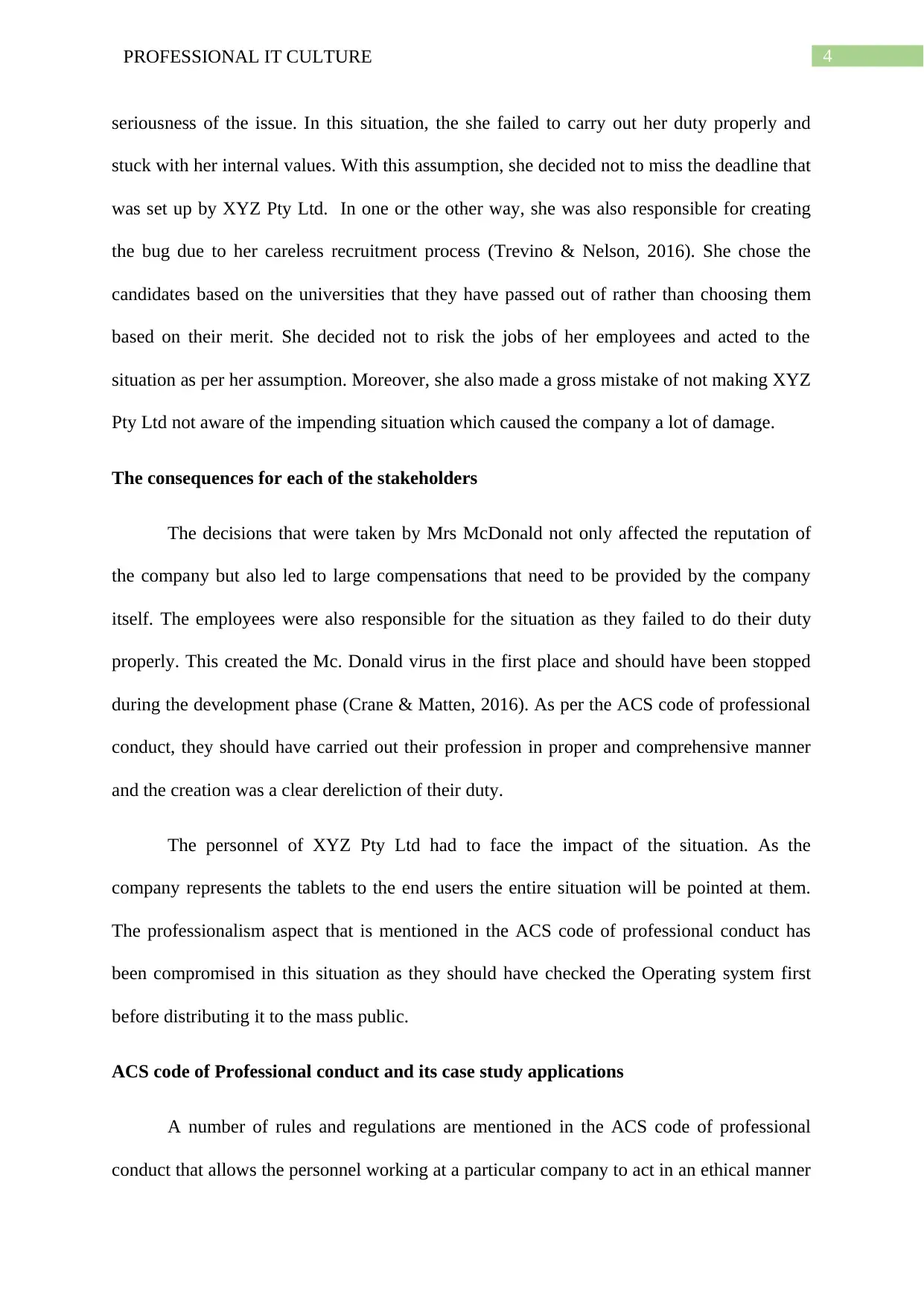
4PROFESSIONAL IT CULTURE
seriousness of the issue. In this situation, the she failed to carry out her duty properly and
stuck with her internal values. With this assumption, she decided not to miss the deadline that
was set up by XYZ Pty Ltd. In one or the other way, she was also responsible for creating
the bug due to her careless recruitment process (Trevino & Nelson, 2016). She chose the
candidates based on the universities that they have passed out of rather than choosing them
based on their merit. She decided not to risk the jobs of her employees and acted to the
situation as per her assumption. Moreover, she also made a gross mistake of not making XYZ
Pty Ltd not aware of the impending situation which caused the company a lot of damage.
The consequences for each of the stakeholders
The decisions that were taken by Mrs McDonald not only affected the reputation of
the company but also led to large compensations that need to be provided by the company
itself. The employees were also responsible for the situation as they failed to do their duty
properly. This created the Mc. Donald virus in the first place and should have been stopped
during the development phase (Crane & Matten, 2016). As per the ACS code of professional
conduct, they should have carried out their profession in proper and comprehensive manner
and the creation was a clear dereliction of their duty.
The personnel of XYZ Pty Ltd had to face the impact of the situation. As the
company represents the tablets to the end users the entire situation will be pointed at them.
The professionalism aspect that is mentioned in the ACS code of professional conduct has
been compromised in this situation as they should have checked the Operating system first
before distributing it to the mass public.
ACS code of Professional conduct and its case study applications
A number of rules and regulations are mentioned in the ACS code of professional
conduct that allows the personnel working at a particular company to act in an ethical manner
seriousness of the issue. In this situation, the she failed to carry out her duty properly and
stuck with her internal values. With this assumption, she decided not to miss the deadline that
was set up by XYZ Pty Ltd. In one or the other way, she was also responsible for creating
the bug due to her careless recruitment process (Trevino & Nelson, 2016). She chose the
candidates based on the universities that they have passed out of rather than choosing them
based on their merit. She decided not to risk the jobs of her employees and acted to the
situation as per her assumption. Moreover, she also made a gross mistake of not making XYZ
Pty Ltd not aware of the impending situation which caused the company a lot of damage.
The consequences for each of the stakeholders
The decisions that were taken by Mrs McDonald not only affected the reputation of
the company but also led to large compensations that need to be provided by the company
itself. The employees were also responsible for the situation as they failed to do their duty
properly. This created the Mc. Donald virus in the first place and should have been stopped
during the development phase (Crane & Matten, 2016). As per the ACS code of professional
conduct, they should have carried out their profession in proper and comprehensive manner
and the creation was a clear dereliction of their duty.
The personnel of XYZ Pty Ltd had to face the impact of the situation. As the
company represents the tablets to the end users the entire situation will be pointed at them.
The professionalism aspect that is mentioned in the ACS code of professional conduct has
been compromised in this situation as they should have checked the Operating system first
before distributing it to the mass public.
ACS code of Professional conduct and its case study applications
A number of rules and regulations are mentioned in the ACS code of professional
conduct that allows the personnel working at a particular company to act in an ethical manner
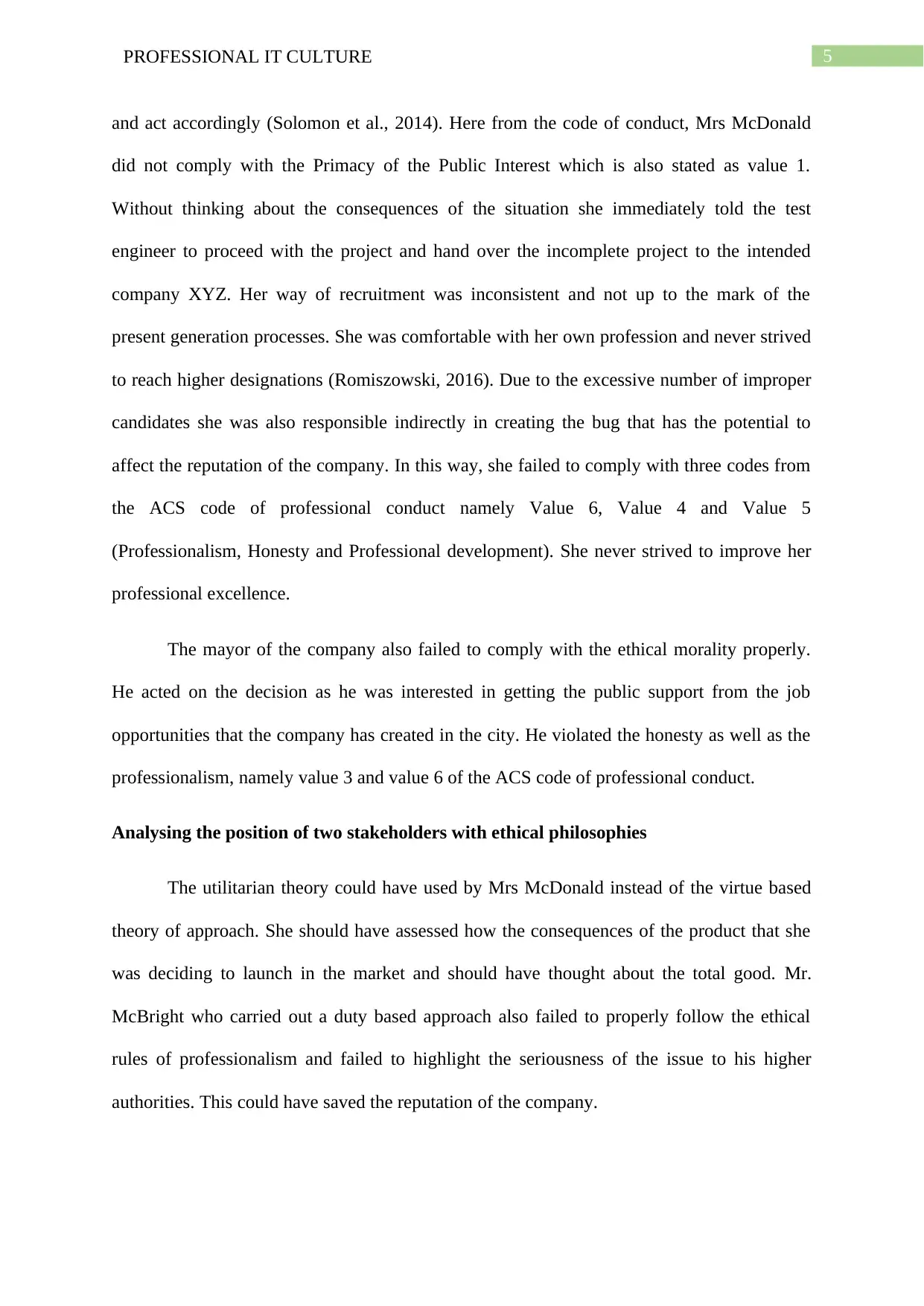
5PROFESSIONAL IT CULTURE
and act accordingly (Solomon et al., 2014). Here from the code of conduct, Mrs McDonald
did not comply with the Primacy of the Public Interest which is also stated as value 1.
Without thinking about the consequences of the situation she immediately told the test
engineer to proceed with the project and hand over the incomplete project to the intended
company XYZ. Her way of recruitment was inconsistent and not up to the mark of the
present generation processes. She was comfortable with her own profession and never strived
to reach higher designations (Romiszowski, 2016). Due to the excessive number of improper
candidates she was also responsible indirectly in creating the bug that has the potential to
affect the reputation of the company. In this way, she failed to comply with three codes from
the ACS code of professional conduct namely Value 6, Value 4 and Value 5
(Professionalism, Honesty and Professional development). She never strived to improve her
professional excellence.
The mayor of the company also failed to comply with the ethical morality properly.
He acted on the decision as he was interested in getting the public support from the job
opportunities that the company has created in the city. He violated the honesty as well as the
professionalism, namely value 3 and value 6 of the ACS code of professional conduct.
Analysing the position of two stakeholders with ethical philosophies
The utilitarian theory could have used by Mrs McDonald instead of the virtue based
theory of approach. She should have assessed how the consequences of the product that she
was deciding to launch in the market and should have thought about the total good. Mr.
McBright who carried out a duty based approach also failed to properly follow the ethical
rules of professionalism and failed to highlight the seriousness of the issue to his higher
authorities. This could have saved the reputation of the company.
and act accordingly (Solomon et al., 2014). Here from the code of conduct, Mrs McDonald
did not comply with the Primacy of the Public Interest which is also stated as value 1.
Without thinking about the consequences of the situation she immediately told the test
engineer to proceed with the project and hand over the incomplete project to the intended
company XYZ. Her way of recruitment was inconsistent and not up to the mark of the
present generation processes. She was comfortable with her own profession and never strived
to reach higher designations (Romiszowski, 2016). Due to the excessive number of improper
candidates she was also responsible indirectly in creating the bug that has the potential to
affect the reputation of the company. In this way, she failed to comply with three codes from
the ACS code of professional conduct namely Value 6, Value 4 and Value 5
(Professionalism, Honesty and Professional development). She never strived to improve her
professional excellence.
The mayor of the company also failed to comply with the ethical morality properly.
He acted on the decision as he was interested in getting the public support from the job
opportunities that the company has created in the city. He violated the honesty as well as the
professionalism, namely value 3 and value 6 of the ACS code of professional conduct.
Analysing the position of two stakeholders with ethical philosophies
The utilitarian theory could have used by Mrs McDonald instead of the virtue based
theory of approach. She should have assessed how the consequences of the product that she
was deciding to launch in the market and should have thought about the total good. Mr.
McBright who carried out a duty based approach also failed to properly follow the ethical
rules of professionalism and failed to highlight the seriousness of the issue to his higher
authorities. This could have saved the reputation of the company.
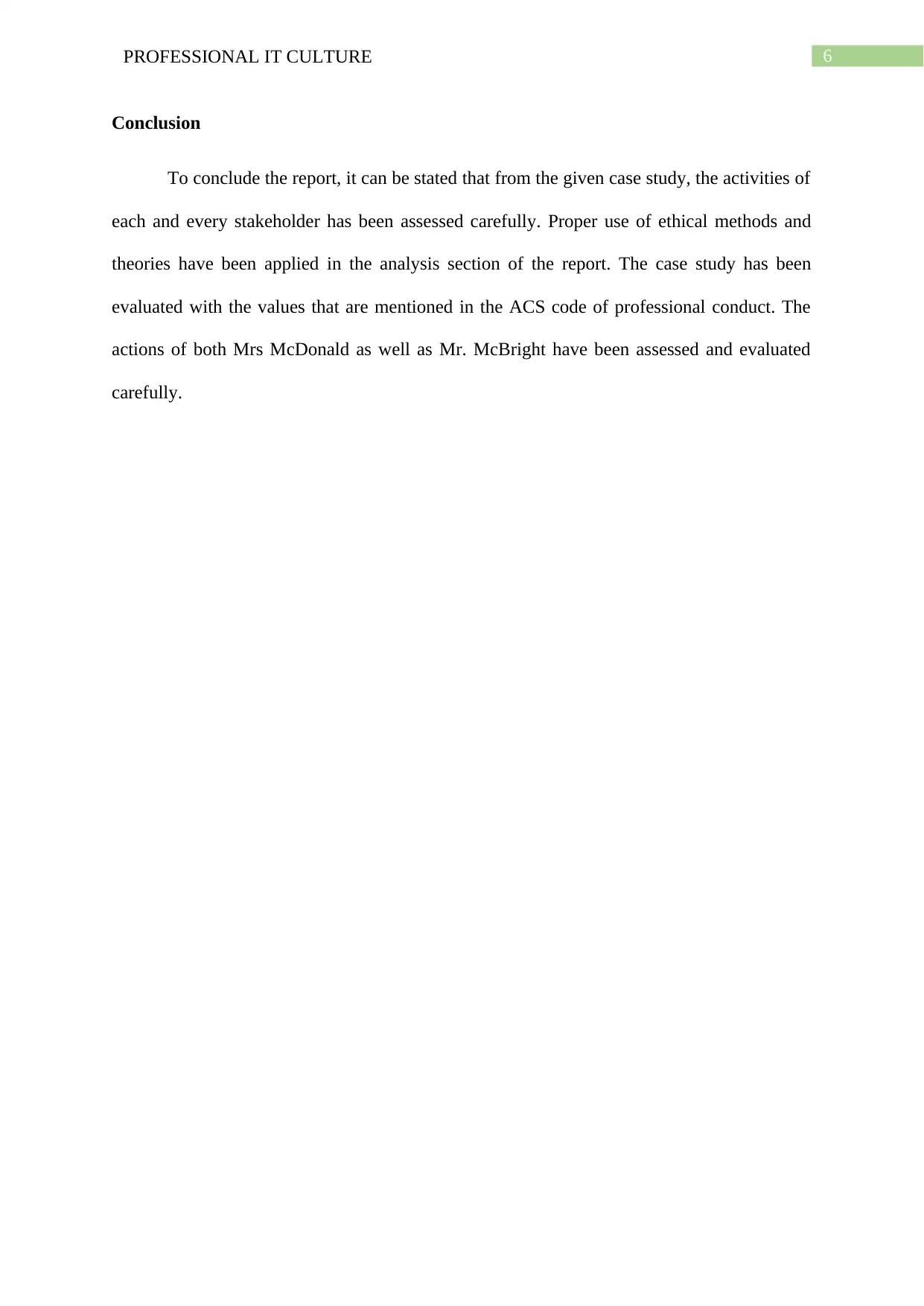
6PROFESSIONAL IT CULTURE
Conclusion
To conclude the report, it can be stated that from the given case study, the activities of
each and every stakeholder has been assessed carefully. Proper use of ethical methods and
theories have been applied in the analysis section of the report. The case study has been
evaluated with the values that are mentioned in the ACS code of professional conduct. The
actions of both Mrs McDonald as well as Mr. McBright have been assessed and evaluated
carefully.
Conclusion
To conclude the report, it can be stated that from the given case study, the activities of
each and every stakeholder has been assessed carefully. Proper use of ethical methods and
theories have been applied in the analysis section of the report. The case study has been
evaluated with the values that are mentioned in the ACS code of professional conduct. The
actions of both Mrs McDonald as well as Mr. McBright have been assessed and evaluated
carefully.
Paraphrase This Document
Need a fresh take? Get an instant paraphrase of this document with our AI Paraphraser
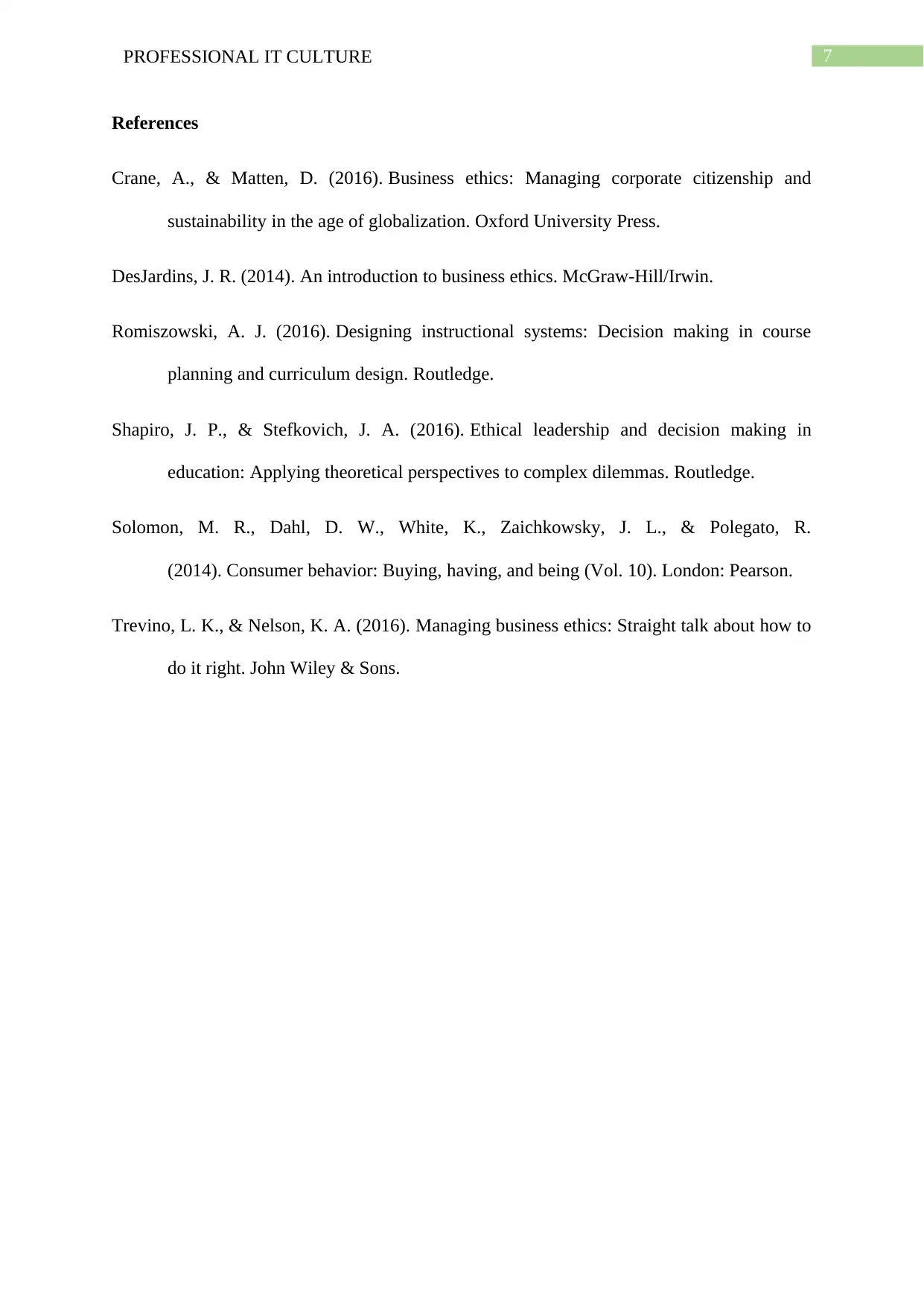
7PROFESSIONAL IT CULTURE
References
Crane, A., & Matten, D. (2016). Business ethics: Managing corporate citizenship and
sustainability in the age of globalization. Oxford University Press.
DesJardins, J. R. (2014). An introduction to business ethics. McGraw-Hill/Irwin.
Romiszowski, A. J. (2016). Designing instructional systems: Decision making in course
planning and curriculum design. Routledge.
Shapiro, J. P., & Stefkovich, J. A. (2016). Ethical leadership and decision making in
education: Applying theoretical perspectives to complex dilemmas. Routledge.
Solomon, M. R., Dahl, D. W., White, K., Zaichkowsky, J. L., & Polegato, R.
(2014). Consumer behavior: Buying, having, and being (Vol. 10). London: Pearson.
Trevino, L. K., & Nelson, K. A. (2016). Managing business ethics: Straight talk about how to
do it right. John Wiley & Sons.
References
Crane, A., & Matten, D. (2016). Business ethics: Managing corporate citizenship and
sustainability in the age of globalization. Oxford University Press.
DesJardins, J. R. (2014). An introduction to business ethics. McGraw-Hill/Irwin.
Romiszowski, A. J. (2016). Designing instructional systems: Decision making in course
planning and curriculum design. Routledge.
Shapiro, J. P., & Stefkovich, J. A. (2016). Ethical leadership and decision making in
education: Applying theoretical perspectives to complex dilemmas. Routledge.
Solomon, M. R., Dahl, D. W., White, K., Zaichkowsky, J. L., & Polegato, R.
(2014). Consumer behavior: Buying, having, and being (Vol. 10). London: Pearson.
Trevino, L. K., & Nelson, K. A. (2016). Managing business ethics: Straight talk about how to
do it right. John Wiley & Sons.
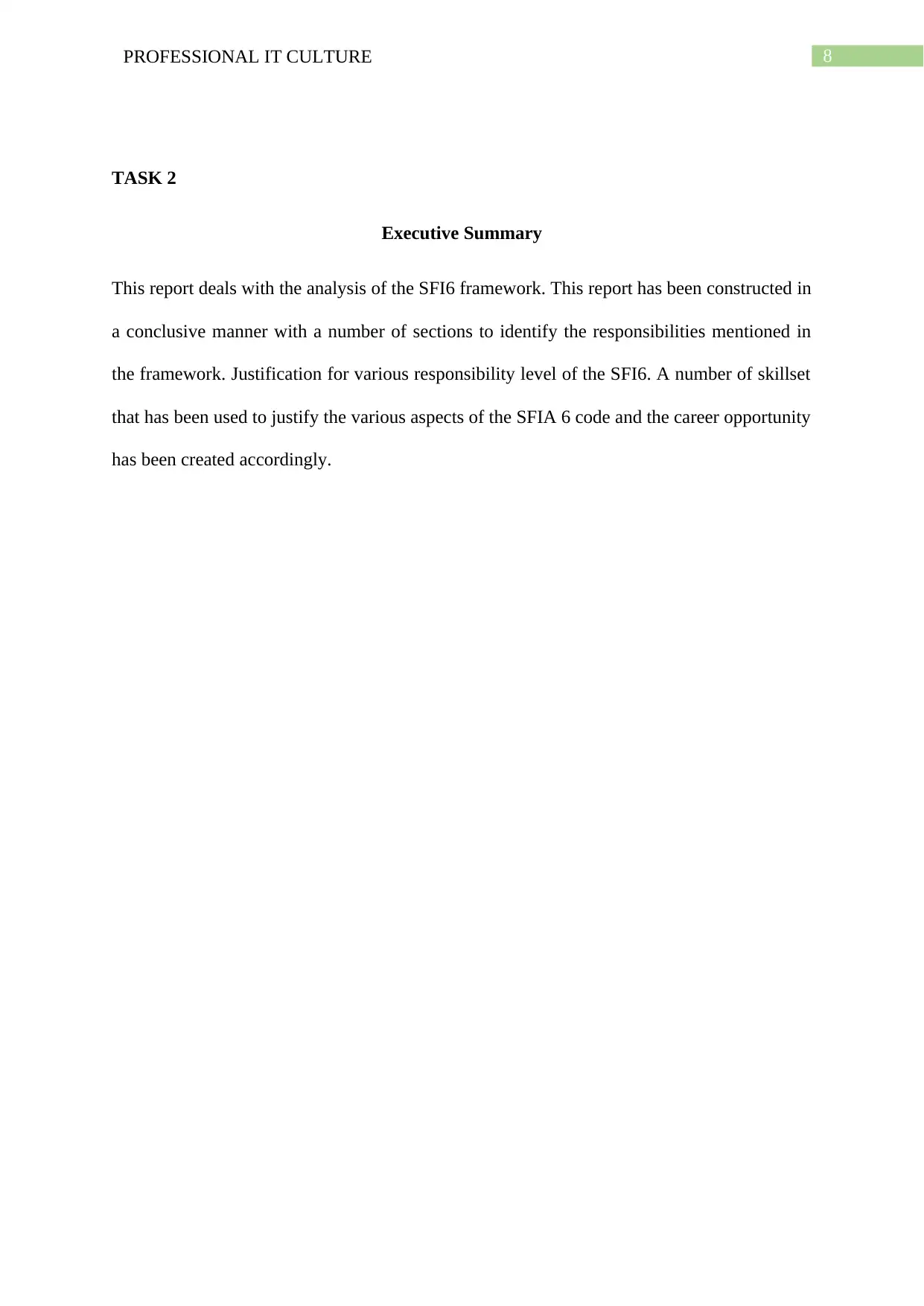
8PROFESSIONAL IT CULTURE
TASK 2
Executive Summary
This report deals with the analysis of the SFI6 framework. This report has been constructed in
a conclusive manner with a number of sections to identify the responsibilities mentioned in
the framework. Justification for various responsibility level of the SFI6. A number of skillset
that has been used to justify the various aspects of the SFIA 6 code and the career opportunity
has been created accordingly.
TASK 2
Executive Summary
This report deals with the analysis of the SFI6 framework. This report has been constructed in
a conclusive manner with a number of sections to identify the responsibilities mentioned in
the framework. Justification for various responsibility level of the SFI6. A number of skillset
that has been used to justify the various aspects of the SFIA 6 code and the career opportunity
has been created accordingly.

9PROFESSIONAL IT CULTURE
Introduction
SFI6 framework has been focusing in the career development of student in the
University. The use of the SFI6 framework has been helping in the development if skills and
knowledge among students sin the university. These skill sets have been maintaining a keen
approach to the Information Age of personal career development. Therefore, a personal
experience in the framework, various skill set have been discussed in the report.
Analysis
Reflective interpretation of SFIA 6
SFI6 framework has been created in order to maintain the incompetence of the ICT
professionals. I have experienced the realization for matching the sill set of different
organization in the different modes. The SFIA 6 is used to each students in every universities.
This framework has been created over 30 organizations including various multinational
companies and governmental organizations (Roy et al., 2014). The working of the framework
is used in order to develop skill sets among students and employees. The management of the
skillset has been depicted in a 2D table. This framework has been used in managing several
responsibilities and is divided into six categories including transformation, change,
implementation and development, strategy, skills and quality, relationships and engagement.
After researching, I learnt about seven levels of responsibilities that have been provided by
the framework known as follow, assist, enable, ensure, advice and apply.
Justification of responsibility level and the required skills for career development
There have been several levels of the framework that can be accessed by the
researchers in the framework. The first level of the framework has been focusing on the
completion of tasks under supervisors and maintaining proper guidelines in order to perform
their responsibilities.
Introduction
SFI6 framework has been focusing in the career development of student in the
University. The use of the SFI6 framework has been helping in the development if skills and
knowledge among students sin the university. These skill sets have been maintaining a keen
approach to the Information Age of personal career development. Therefore, a personal
experience in the framework, various skill set have been discussed in the report.
Analysis
Reflective interpretation of SFIA 6
SFI6 framework has been created in order to maintain the incompetence of the ICT
professionals. I have experienced the realization for matching the sill set of different
organization in the different modes. The SFIA 6 is used to each students in every universities.
This framework has been created over 30 organizations including various multinational
companies and governmental organizations (Roy et al., 2014). The working of the framework
is used in order to develop skill sets among students and employees. The management of the
skillset has been depicted in a 2D table. This framework has been used in managing several
responsibilities and is divided into six categories including transformation, change,
implementation and development, strategy, skills and quality, relationships and engagement.
After researching, I learnt about seven levels of responsibilities that have been provided by
the framework known as follow, assist, enable, ensure, advice and apply.
Justification of responsibility level and the required skills for career development
There have been several levels of the framework that can be accessed by the
researchers in the framework. The first level of the framework has been focusing on the
completion of tasks under supervisors and maintaining proper guidelines in order to perform
their responsibilities.
Secure Best Marks with AI Grader
Need help grading? Try our AI Grader for instant feedback on your assignments.
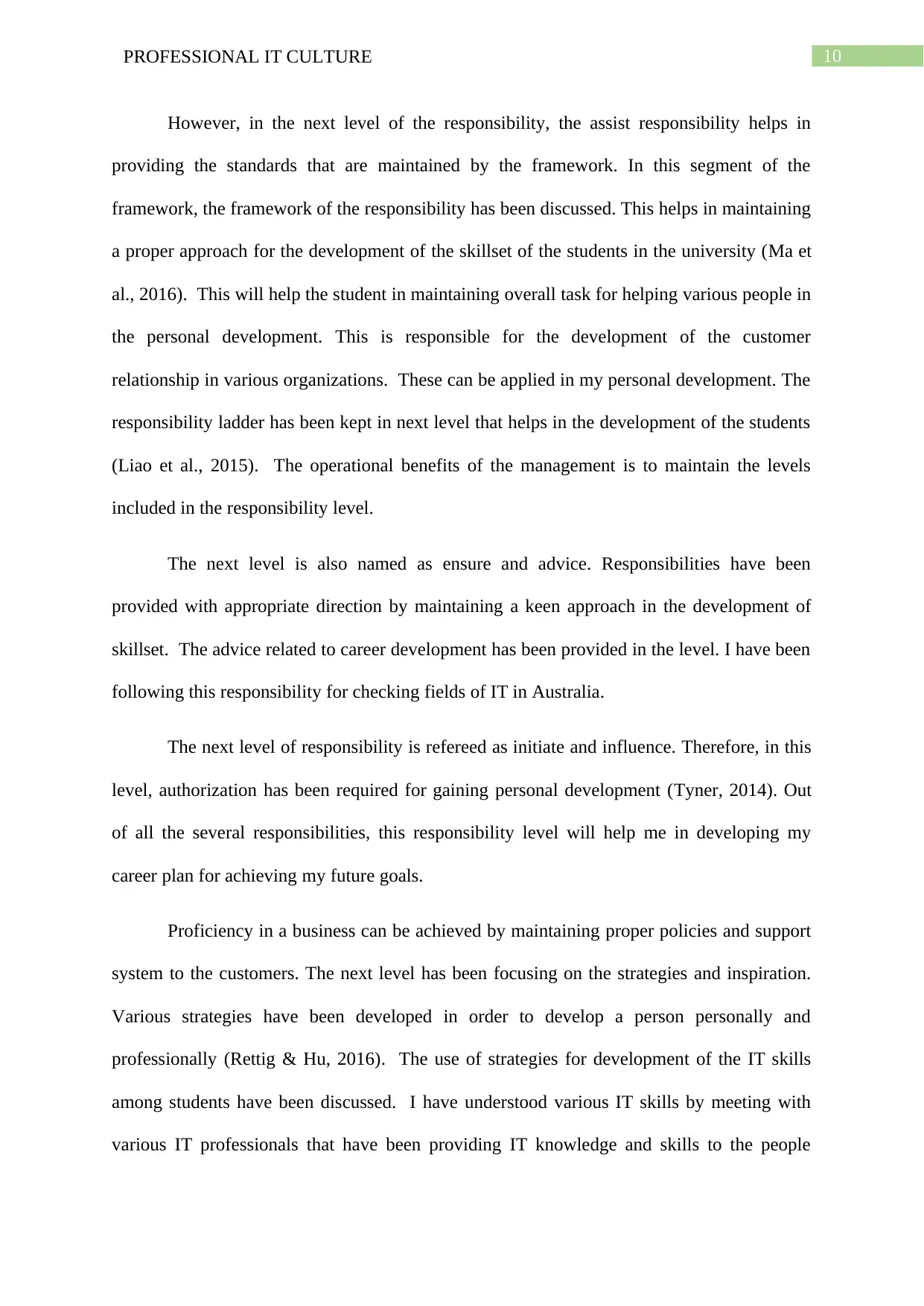
10PROFESSIONAL IT CULTURE
However, in the next level of the responsibility, the assist responsibility helps in
providing the standards that are maintained by the framework. In this segment of the
framework, the framework of the responsibility has been discussed. This helps in maintaining
a proper approach for the development of the skillset of the students in the university (Ma et
al., 2016). This will help the student in maintaining overall task for helping various people in
the personal development. This is responsible for the development of the customer
relationship in various organizations. These can be applied in my personal development. The
responsibility ladder has been kept in next level that helps in the development of the students
(Liao et al., 2015). The operational benefits of the management is to maintain the levels
included in the responsibility level.
The next level is also named as ensure and advice. Responsibilities have been
provided with appropriate direction by maintaining a keen approach in the development of
skillset. The advice related to career development has been provided in the level. I have been
following this responsibility for checking fields of IT in Australia.
The next level of responsibility is refereed as initiate and influence. Therefore, in this
level, authorization has been required for gaining personal development (Tyner, 2014). Out
of all the several responsibilities, this responsibility level will help me in developing my
career plan for achieving my future goals.
Proficiency in a business can be achieved by maintaining proper policies and support
system to the customers. The next level has been focusing on the strategies and inspiration.
Various strategies have been developed in order to develop a person personally and
professionally (Rettig & Hu, 2016). The use of strategies for development of the IT skills
among students have been discussed. I have understood various IT skills by meeting with
various IT professionals that have been providing IT knowledge and skills to the people
However, in the next level of the responsibility, the assist responsibility helps in
providing the standards that are maintained by the framework. In this segment of the
framework, the framework of the responsibility has been discussed. This helps in maintaining
a proper approach for the development of the skillset of the students in the university (Ma et
al., 2016). This will help the student in maintaining overall task for helping various people in
the personal development. This is responsible for the development of the customer
relationship in various organizations. These can be applied in my personal development. The
responsibility ladder has been kept in next level that helps in the development of the students
(Liao et al., 2015). The operational benefits of the management is to maintain the levels
included in the responsibility level.
The next level is also named as ensure and advice. Responsibilities have been
provided with appropriate direction by maintaining a keen approach in the development of
skillset. The advice related to career development has been provided in the level. I have been
following this responsibility for checking fields of IT in Australia.
The next level of responsibility is refereed as initiate and influence. Therefore, in this
level, authorization has been required for gaining personal development (Tyner, 2014). Out
of all the several responsibilities, this responsibility level will help me in developing my
career plan for achieving my future goals.
Proficiency in a business can be achieved by maintaining proper policies and support
system to the customers. The next level has been focusing on the strategies and inspiration.
Various strategies have been developed in order to develop a person personally and
professionally (Rettig & Hu, 2016). The use of strategies for development of the IT skills
among students have been discussed. I have understood various IT skills by meeting with
various IT professionals that have been providing IT knowledge and skills to the people
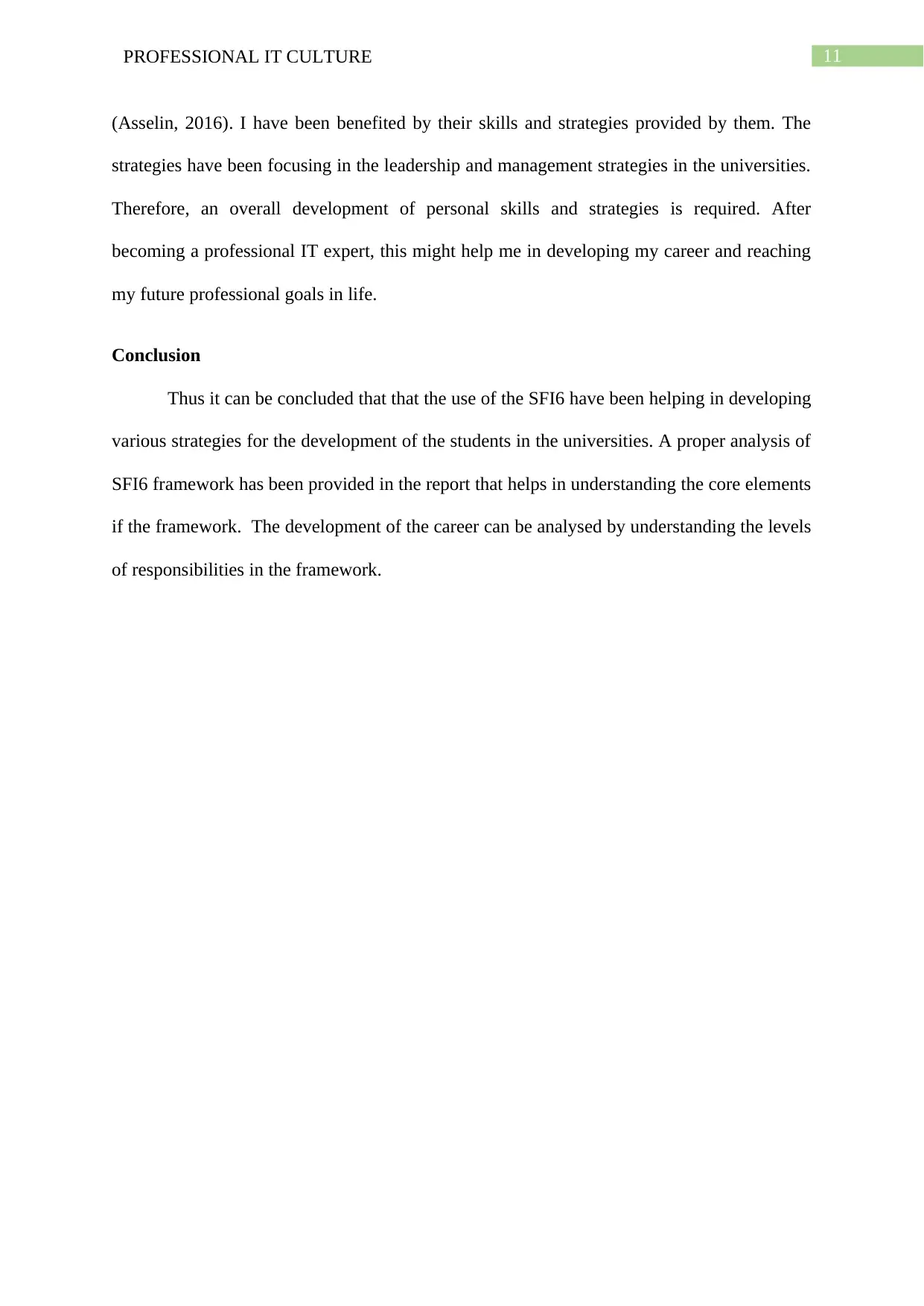
11PROFESSIONAL IT CULTURE
(Asselin, 2016). I have been benefited by their skills and strategies provided by them. The
strategies have been focusing in the leadership and management strategies in the universities.
Therefore, an overall development of personal skills and strategies is required. After
becoming a professional IT expert, this might help me in developing my career and reaching
my future professional goals in life.
Conclusion
Thus it can be concluded that that the use of the SFI6 have been helping in developing
various strategies for the development of the students in the universities. A proper analysis of
SFI6 framework has been provided in the report that helps in understanding the core elements
if the framework. The development of the career can be analysed by understanding the levels
of responsibilities in the framework.
(Asselin, 2016). I have been benefited by their skills and strategies provided by them. The
strategies have been focusing in the leadership and management strategies in the universities.
Therefore, an overall development of personal skills and strategies is required. After
becoming a professional IT expert, this might help me in developing my career and reaching
my future professional goals in life.
Conclusion
Thus it can be concluded that that the use of the SFI6 have been helping in developing
various strategies for the development of the students in the universities. A proper analysis of
SFI6 framework has been provided in the report that helps in understanding the core elements
if the framework. The development of the career can be analysed by understanding the levels
of responsibilities in the framework.

12PROFESSIONAL IT CULTURE
References
Asselin, M. (2016). Teaching information skills in the information age: An examination of
trends in the middle grades. Librarians and Educators Collaborating for Success: The
International Perspective, 82.
Liao, R., Tao, X., Li, R., Ma, Z., & Jia, J. (2015). Video super-resolution via deep draft-
ensemble learning. In Proceedings of the IEEE International Conference on
Computer Vision (pp. 531-539).
Ma, S., Zhang, X., Zhang, J., Jia, C., Wang, S., & Gao, W. (2016). Nonlocal in-loop filter:
The way toward next-generation video coding?. IEEE MultiMedia, 23(2), 16-26.
Rettig, J., & Hu, S. (2016). College sport participation and student educational experiences
and selected college outcomes. Journal of College Student Development, 57(4), 428-
446.
Roy, R., Chen, W., Cong, L., Goodell, L. A., Foran, D. J., & Desai, J. P. (2014). Probabilistic
estimation of mechanical properties of biomaterials using atomic force
microscopy. IEEE Transactions on Biomedical Engineering, 61(2), 547-556.
Tyner, K. (2014). Literacy in a digital world: Teaching and learning in the age of
information. Routledge.
References
Asselin, M. (2016). Teaching information skills in the information age: An examination of
trends in the middle grades. Librarians and Educators Collaborating for Success: The
International Perspective, 82.
Liao, R., Tao, X., Li, R., Ma, Z., & Jia, J. (2015). Video super-resolution via deep draft-
ensemble learning. In Proceedings of the IEEE International Conference on
Computer Vision (pp. 531-539).
Ma, S., Zhang, X., Zhang, J., Jia, C., Wang, S., & Gao, W. (2016). Nonlocal in-loop filter:
The way toward next-generation video coding?. IEEE MultiMedia, 23(2), 16-26.
Rettig, J., & Hu, S. (2016). College sport participation and student educational experiences
and selected college outcomes. Journal of College Student Development, 57(4), 428-
446.
Roy, R., Chen, W., Cong, L., Goodell, L. A., Foran, D. J., & Desai, J. P. (2014). Probabilistic
estimation of mechanical properties of biomaterials using atomic force
microscopy. IEEE Transactions on Biomedical Engineering, 61(2), 547-556.
Tyner, K. (2014). Literacy in a digital world: Teaching and learning in the age of
information. Routledge.
1 out of 13
Related Documents
Your All-in-One AI-Powered Toolkit for Academic Success.
+13062052269
info@desklib.com
Available 24*7 on WhatsApp / Email
![[object Object]](/_next/static/media/star-bottom.7253800d.svg)
Unlock your academic potential
© 2024 | Zucol Services PVT LTD | All rights reserved.



